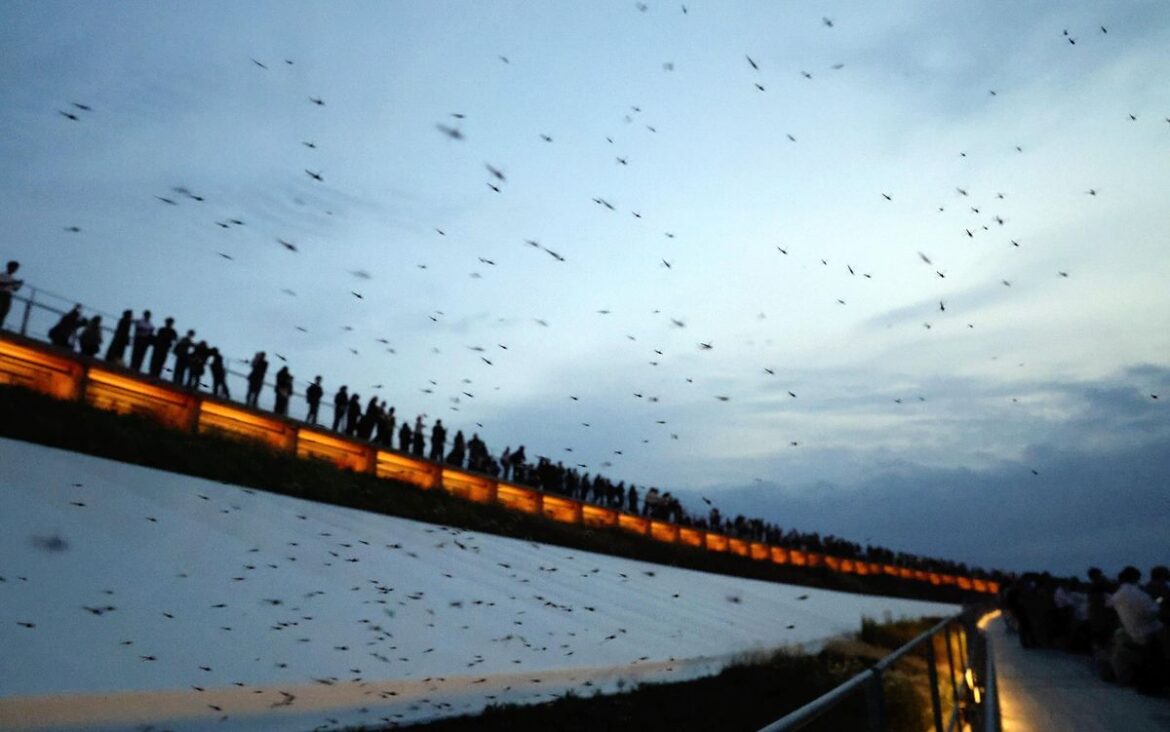
The Yomiuri Shimbun
Chironomids gather around the Grand Ring at the 2025 Osaka-Kansai Expo in Konoha Ward, Osaka, on Friday.
6:00 JST, May 26, 2025
Swarms of mosquito-like insects are bugging visitors at the 2025 Osaka-Kansai Expo, prompting organizers to take countermeasures.
The insects, called chironomids, do not bite people or suck their blood, but that has not made them any less unpopular with Expo visitors, who describe them as “disgusting.”
Organizers are working with insecticide makers to contain the outbreak.
At around 7 p.m. on Friday, after the sun had set and the remaining light was fading, we were walking along the promenade of the Grand Ring on the south side of the venue when we felt something hit us in the face. The next moment, a swarm of bugs appeared.
Many of the visitors who had climbed the ring to see a nighttime water show began brushing the bugs off themselves with their hands or putting on masks.
“It was not this bad when I came at the end of April,” said a 70-year-old woman from Osaka City who visited the event with four friends. “I had heard about the bugs on the news. They almost got in my eyes, which was disgusting.”
The Japan Association for the 2025 World Exposition, the expo organizer, later identified the insects as chironomids. The bugs are believed to have spawned mainly in the Water Plaza, a wide seawater area on the south side of the venue.
The chironomid belongs to the Diptera order. There are reportedly 1,000 to 2,000 species of chironomids in Japan. According to Toyo Sangyo Co., a pest control company in Okayama City, and others, adult chironomids measure about 0.5 millimeters to 1 centimeter.
They lay their eggs in rivers, irrigation canals and puddles. The larvae feed on organic matter in the water, which helps improve the water quality — one positive aspect to them. The adults are active from dusk to night and often gather around lights. When mating, they fly in swarms to form what is called a mosquito column. They do not feed. After hatching, they mate, lay eggs and die. Their lifespan is only a few days. In extremely rare cases, they can cause an allergic reaction in humans if they enter the mouth.
Nao Yamamoto of Mizuken, an environmental analysis company in Sakai, Osaka Prefecture, examined insects collected at the Expo site and found them to be a species known as Chironomus salinarius Kieffer. The species is salt-tolerant and lives in areas where fresh water and seawater mix, and outbreaks peak in May and June, he said.
According to Yamamoto, the outbreak at the Expo venue is due mainly to the existence of the Water Plaza and the absence of competing salt-tolerant creatures and natural predators in the area.
The Expo association has sprayed an insect growth inhibitor over puddles and planting zones on the Grand Ring. It has also consulted with experts and the Environment Ministry on how to deal with the problem.
Osaka Gov. Hirofumi Yoshimura said at a news conference on Wednesday that he had asked Earth Corp., a major insecticide company in Tokyo, to help solve the problem.


AloJapan.com